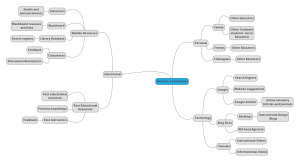
Distance learning has been put in the spotlight recently because of the increased need for learners to learn independently and not in a classroom because of public health concerns. Before starting EDUC-6135, Distance Learning, I viewed distance learning more as “self-study”, while self-study can be a component of distance learning, that is not the whole premise. This week after learning more about distance learning, I have evolved my definition to include the important aspect of feedback from both learners and instructors. It is noted that students, especially younger students, can benefit from the independence that distance learning offers, but too much independence and lack of interaction can also have a negative impact (Huett et al, 2008).
My personal definition of distance learning involves both the instructor and the learners. Because distance education incorporates both teaching and learning (Laureate Education, n.d.). My definition of distance learning is learning and studying in a different location from other learners and the instructor. Distance learning should involve interaction, collaboration and use of technology to aide in learning. Students and instructors both have to work to keep the line of communication open between themselves so that cooperative learning can be achieved.
Distance learning has gone though major changes since it has been defined, and more so over the past few months even. The effectiveness of the learning strategies and technologies used in distance education need to be evaluated regularly to achieve optimal learning (Moller et al, 2008). Distance learning has evolved from pen, and paper, with a print textbook where students studied alone and then mailed in their assignments. Distance education and learning has many facets that all interact together to create a learning environment where students might be better off than traditional classroom learning.
Distance Learning should encourage active learning (Mahlangu, 2018). In classroom learning sometimes it is hard to give students ample opportunities for participation and active learning. Traditionally, classrooms are spatially ineffective, with only a few students near the front and many in the middle or the back of the classroom where participation Is hard. In distance learning, every student gets a close up and personal seat to the instructor and the instructor also gets a clear view of who is engaged. Through distance learning, instructors can influence collaboration by introducing technology that specialize in team work and collaboration among peers that are geographically separated.
The future of distance learning will involve continued research on effective learning strategies matched with technology to aide in learning (Mahlangu, 2018). Distance learning will continue to evolve with the evolving and changing needs of learners. Schools can benefit from the incorporation of distance learning strategies into their traditional classrooms to increase opportunities for student success. The more distance learning is utilized the more we can learn about the effectiveness of the concept.
I created a mind map of my personal definition of distance learning using Lucidchart, which is a free web based diagram and chart maker. Retrieved from https://chrome.google.com/webstore/detail/lucidchart-diagrams/apboafhkiegglekeafbckfjldecefkhn
References
Mahlangu, V. P., (2018). The good, the bad, the ugly of distance learning in higher education. Trends in e-learning, 17-59. Retrieved from https://scholar.google.com/scholar?cluster=16401816206790670741&hl=en&as_sdt=5,47&sciodt=0,47
Moller, L., Foshay, W., & Huett, J. (2008). The evolution of distance education: Implications for instructional design on the potential of the web (Part 2: Higher education). TechTrends, 52(4), 66–70.
Huett, J., Moller, L., Foshay, W., & Coleman, C. (2008). The evolution of distance education: Implications for instructional design on the potential of the web (Part 3: K12). TechTrends, 52(5), 63-67.
Laureate Education (Producer). (n.d.). Distance education: The next generation [Video file]. Retrieved from https://class.waldenu.edu



 e in schools. I think of myself as not too bad with new technology when it is presented to me, but I am definitely far from someone that knows it all or feels like I grew up with it. Because of this learning is different for me that it would be for someone in high school now, or even in college undergrad. This is something that I will consider from now on when I think of my learning style.
e in schools. I think of myself as not too bad with new technology when it is presented to me, but I am definitely far from someone that knows it all or feels like I grew up with it. Because of this learning is different for me that it would be for someone in high school now, or even in college undergrad. This is something that I will consider from now on when I think of my learning style.
